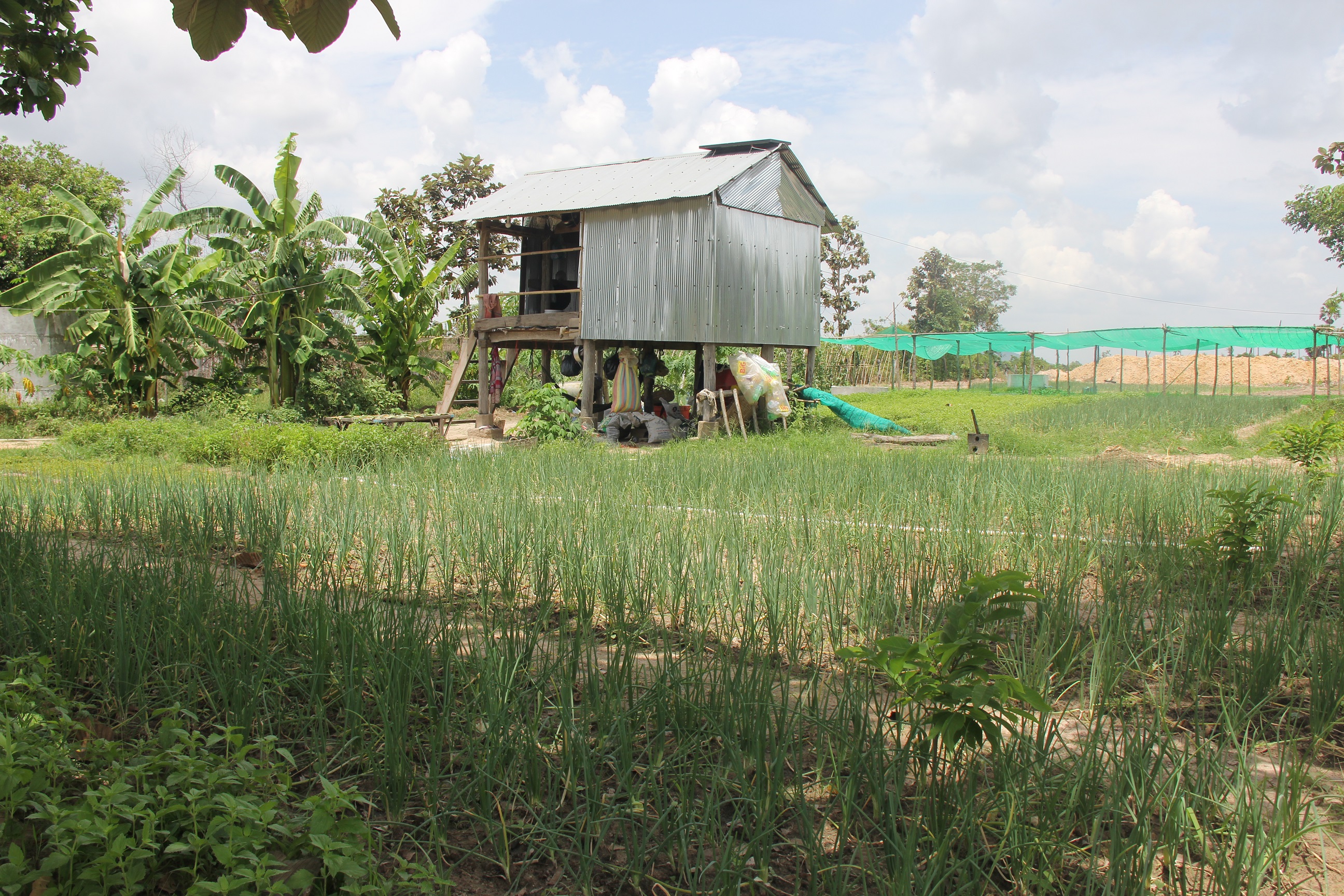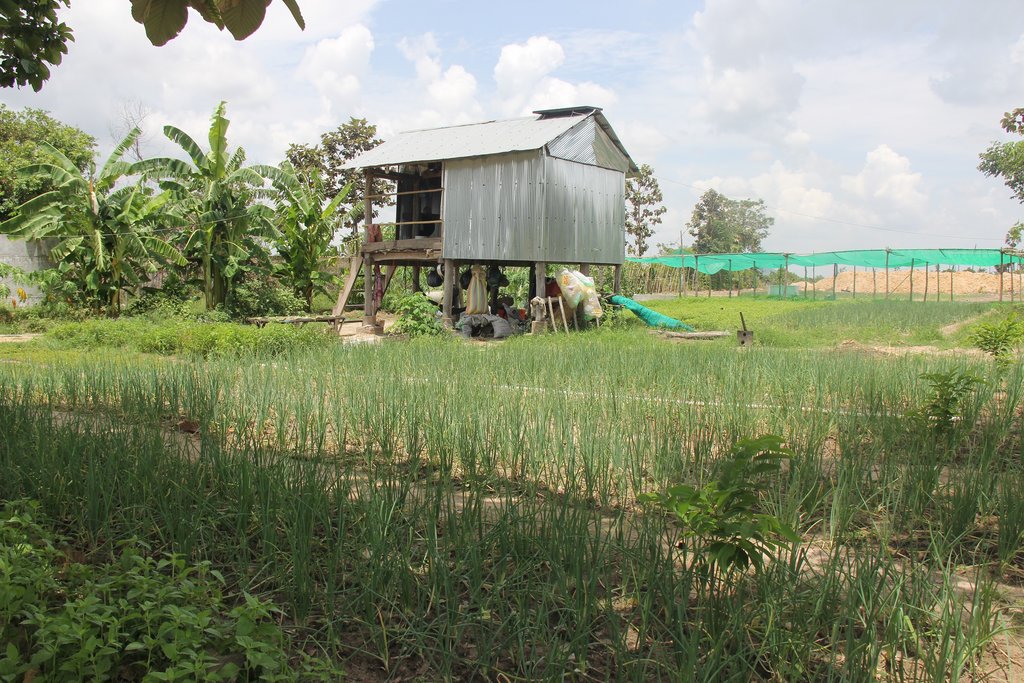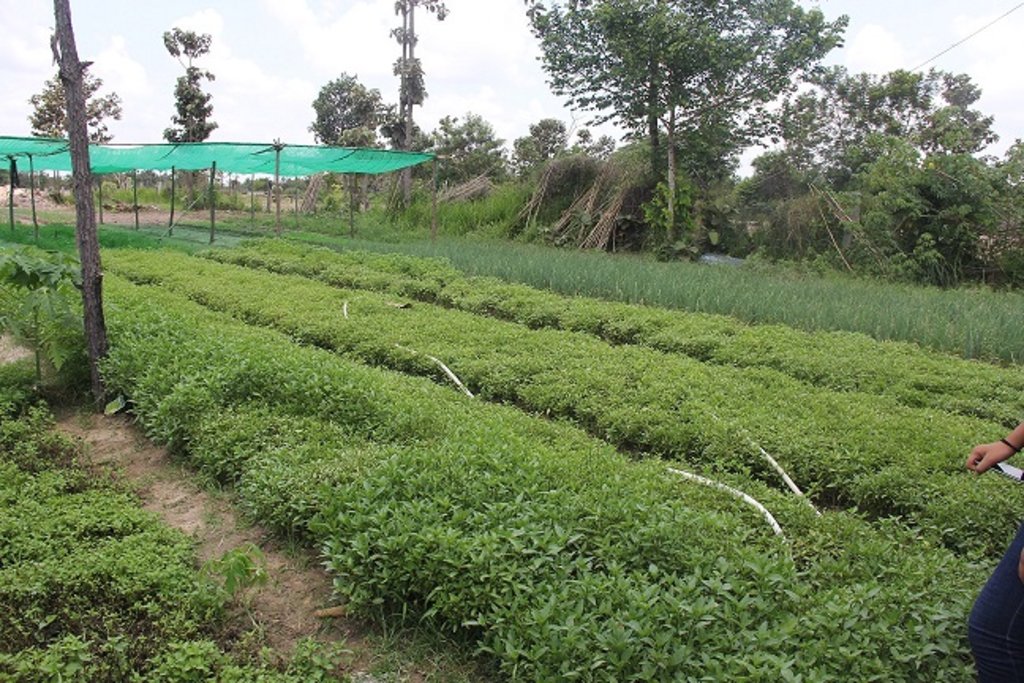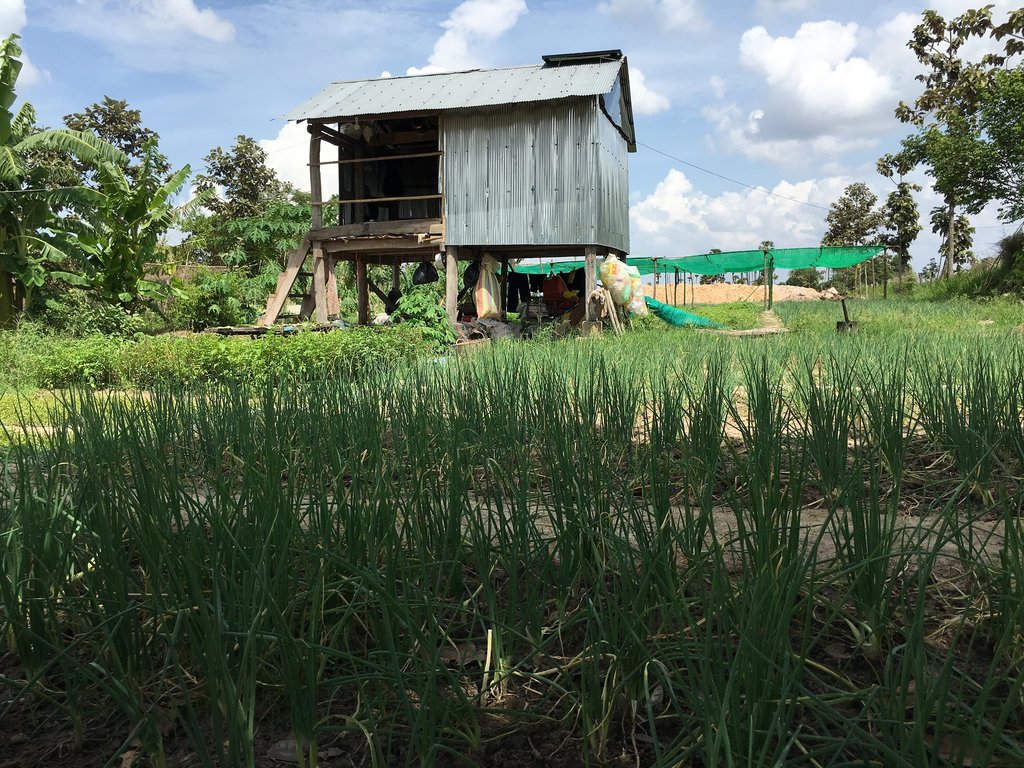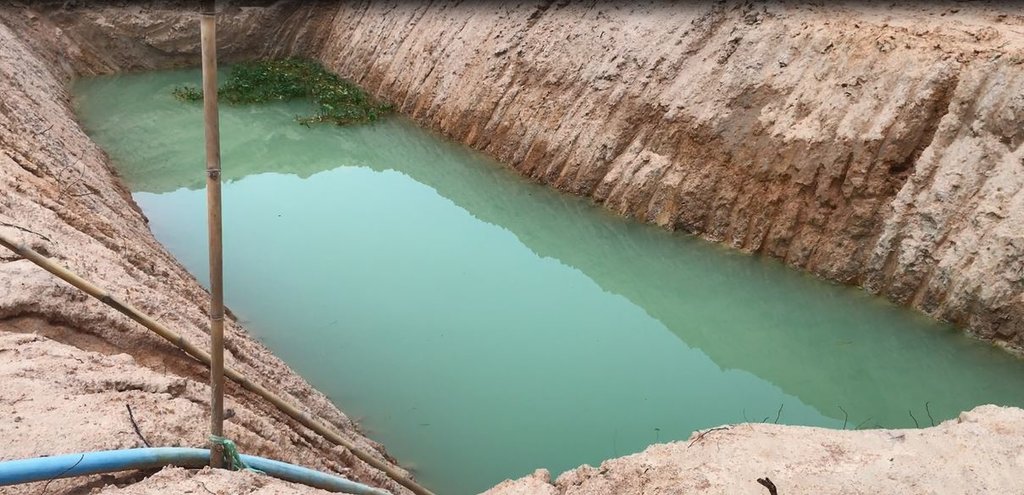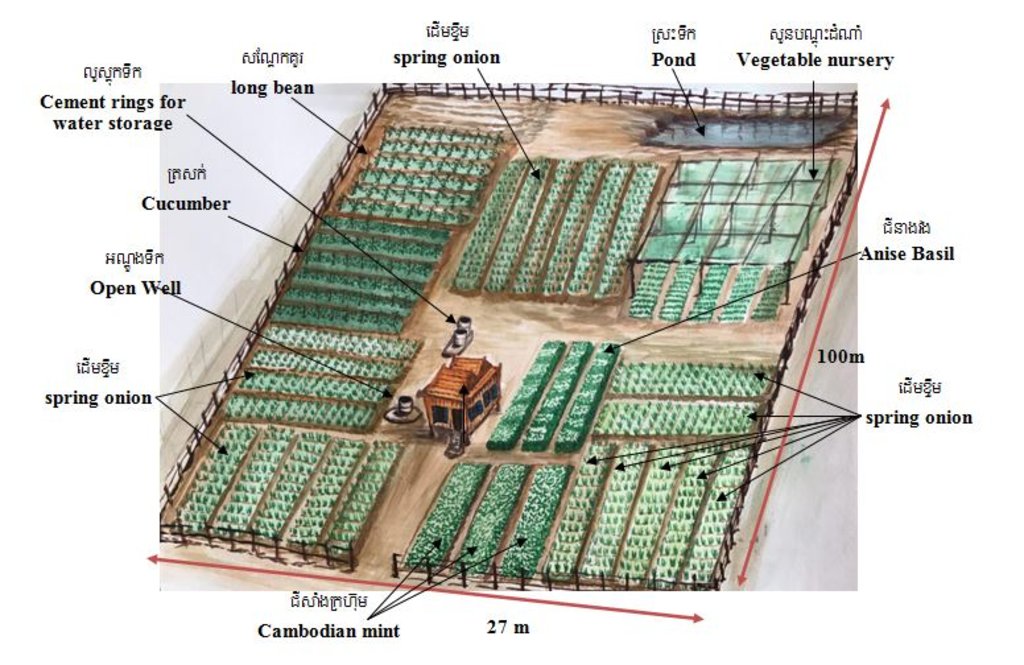Crop diversification with the application of rotation techniques [Camboja]
- Criação:
- Atualização:
- Compilador/a: Navin Chea
- Editores: Sophea Tim, Sok Pheak
- Revisores: Nimul CHUN, Ursula Gaemperli, Alexandra Gavilano
Crop diversification farm
technologies_3145 - Camboja
Veja as seções
Expandir tudo Recolher tudo1. Informação geral
1.2 Detalhes do contato das pessoas capacitadas e instituições envolvidas na avaliação e documentação da tecnologia
Pessoa(s) capacitada(s)
usuário de terra:
Phrum Thon
Land User
Camboja
Vice Chief of Agronomy Office at Agricultural Office of Rolea B'ier:
Chhim Bunleang
Agricultural Office of Rolea B'ier.
Camboja
Vice Chief of Agricultural Extension Office at Provincial Department of Agriculture, Forestry and Fisheries, Kampong Chhnang province:
Chief of Agricultural Office of Tuek Phos:
Nome do projeto que facilitou a documentação/avaliação da Tecnologia (se relevante)
Scaling-up SLM practices by smallholder farmers (IFAD)Nome da(s) instituição(ões) que facilitou(ram) a documentação/ avaliação da Tecnologia (se relevante)
Royal University of Agriculture (RUA) - Camboja1.3 Condições em relação ao uso da informação documentada através de WOCAT
O/a compilador/a e a(s) pessoa(s) capacitada(s) aceitam as condições relativas ao uso de dados documentados através da WOCAT:
Sim
1.4 Declaração de sustentabilidade da tecnologia descrita
A tecnologia descrita aqui é problemática em relação a degradação da terra de forma que não pode ser declarada uma tecnologia de gestão sustentável de terra?
Não
2. Descrição da tecnologia de GST
2.1 Descrição curta da tecnologia
Definição da tecnologia:
Crop diversification is the practice of simultaneously cultivating two or multiple varieties of crops in a given area whilst at the same time applying crop rotation and/or intercropping. In this case study the land user has been practicing crop diversification with eleven different crop varieties.
2.2 Descrição detalhada da tecnologia
Descrição:
Crop diversification entails simultaneously growing two or multiple varieties of crops in a particular place with the application of crop rotation techniques and/or intercropping. The selection of the crop varieties will depend on the purpose of the land user. In general, a diversity of crops will provide a range of benefits such as food security, nutritional diversity, income generation, soil conservation, pest and disease control as well as adaptation to climate change (CGIAR, 2017, Makate et al, 2016, MoEYS& VVOB Cambodia, 2013).
Mrs. Prum Thon has been cultivating a diversity of crops with the application of rotation techniquesfor about 10 years, which involves exchanging an entire crop in a particular row. This means that cultivation can take place throughout the year without having to leave the land fallow. At the time of the interview eleven different crops had been cultivated including spring onions, anise basil, Cambodian mint, bok choy, choy sum, escarole, mint, long beans, cucumbers, bitter melons and lettuce. Almost all of these crops have an average lifespan of three months, except for the anise basil which can grow for one or two years depending on the way it is cultivated. After she has harvested a particular crop, she will then rotate this crop row with a new distinctive crop species. For instance after having harvested spring onions she will then plant mint in that row, and in the row where she was previously growing mint, she will rotate that with either spring onions or cucumbers.
The practice of crop diversification whilst at the same time rotating the crop in each of the rows aims to achieve the following main objectives:
Crop diversification enables the farmer to generate a daily income to offset her daily expenses which thereby becomes a means of improving her livelihood. Growing a diversity of crops can also enable her to meet a variety of market demands and generate a high daily income. If a farmer grows only one crop specie she can usually earn about 15,000 Riel per day, but if she plants four crop species such as anise basil, bok choy, long beans and cucumbers she can increase her income to about 20,000 Riel per day, However if she grows one more specie such as lettuce or grows eleven different crops, she would be able to increase her income up to 40,000 or 80,000 Riel per day. The practice of crop diversification enables her to generate an income on a daily basis.
Crop diversification with the rotation of the crop in each row after the harvest could assist in reducing soil degradation. According to her experience and observations each crop absorbs different nutrients from the soil. If one row is repeatedly used to cultivate spring onions, they tend not to flourish so well and the roots have a tendency to decay. However if they are rotated with another crop and the spring onions are then grown in another row, they are able to thrive and the roots and stems are less likely to spoil. Crop diversification also has other functions as the cover crops help to reduce soil degradation through expose to sunlight, maintain soil moisture, make the soil less compact and add beneficial micro-organisms to the soil. In addition crop diversification can control pests especially the practice of growing companion plants such as herbs or spring onions as this can prevent crops from being damaged by pests.
The use of this technology assists in improving livelihoods, reduces migration because she does not need to move in order to find a job in another location, and enables her to generate a daily income. In addition this technology is able to reduce the risk of crop failure resulting from damage by pests and insects.Furthermore it reduces the risks associated with changes in market demand as the farmer produces a diversity of crops and also it prevents and reduces soil degradation. In order to effectively use this technology there needs to be sufficient water supply such as a river, stream, well or pond.This enables the land user to grow crops throughout the year round and reduces damage of crops as the result of unpredictable adverse climate conditions such as changes in rainfall, or the occurrence of drought.
2.3 Fotos da tecnologia
2.5 País/região/locais onde a tecnologia foi aplicada e que estão cobertos nesta avaliação
País:
Camboja
Região/Estado/Província:
Ruessei Duoch village, Banteay Peal Commune, Rolea B'ier District, Kampong Chhnang Province.
Especifique a difusão da tecnologia:
- Uniformemente difundida numa área
Se a Tecnologia estiver uniformemente distribuída por uma área, especifique a área coberta (em km2):
0,0027
Se a área precisa não for conhecida, indicar a área aproximada coberta:
- < 0,1 km2 (10 ha)
Comentários:
It is spread over an area of 2700 square meters.
Map
×2.6 Data da implementação
Caso o ano exato seja desconhecido, indique a data aproximada:
- 10-50 anos atrás
2.7 Introdução da tecnologia
Especifique como a tecnologia foi introduzida:
- atráves de inovação dos usuários da terra
- durante experiências/ pesquisa
- através de projetos/intervenções externas
Comentários (tipos de projeto, etc.):
Through her experience and training from Cambodian Center for Study and Development in Agriculture (CEDAC).
3. Classificação da tecnologia de GST
3.1 Principal/principais finalidade(s) da tecnologia
- Melhora a produção
- Reduz, previne, recupera a degradação do solo
- Criar impacto econômico benéfico
3.2 Tipo(s) atualizado(s) de uso da terra onde a tecnologia foi aplicada

Terra de cultivo
- Cultura anual
Cultivo anual - Especificar culturas:
- legumes - raízes (cenouras, cebolas, beterraba, outros)
- legumes - melão, abóbora ou aboborinha
- vegetais - vegetais de folhas (saladas, couve, espinafre, outros)
- Legumes e leguminosas - feijão
- plantas e ervas medicinais/ aromáticas/pesticidas
- cucumber
Sistema de cultivo anual:
Legumes - trigo/cevada/aveia/arroz de terras altas
Número de estações de cultivo por ano:
- 3
Especifique:
Crop rotation throughout the whole year. The land is alway coverd by corps (no fallow period).
O rodízio de culturas é praticado?
Sim
Comentários:
Spring onion, anise basil, Cambodian mint, bok choy, escarole, choy sum, mint, long bean, cucumber, bitter melon, lettuce.
3.3 O uso do solo mudou devido à implementação da Tecnologia?
O uso do solo mudou devido à implementação da Tecnologia?
- Sim (Por favor, preencha as perguntas abaixo com relação ao uso do solo antes da implementação da Tecnologia)

Floresta/bosques
Comentários:
Degraded forest land.
3.4 Abastecimento de água
Abastecimento de água para a terra na qual a tecnologia é aplicada:
- Misto de precipitação natural-irrigado
Comentários:
There is one open well and a pond for crop irrigation during drought.
3.5 Grupo de GST ao qual pertence a tecnologia
- sistema rotativo (rotação de culturas, pousios, cultivo itinerante)
- Gestão integrada de fertilidade do solo
- Gestão integrada de pragas e doenças (inclusive agricultura orgânica)
3.6 Medidas de GST contendo a tecnologia

Medidas agronômicas
- A1: cobertura vegetal/do solo
- A2: Matéria orgânica/fertilidade do solo

Medidas estruturais
- S5: Represa, bacia, lago

Outras medidas
Comentários:
The farmer grows specific companion plants on the same plot with the aim of improving the plant growth and the pest control.
3.7 Principais tipos de degradação da terra abordados pela tecnologia

Deteriorização química do solo
- Cn: declínio de fertilidade e teor reduzido de matéria orgânica (não causado pela erosão)

Deteriorização física do solo
- Pc: Compactação

Degradação biológica
- Bc: redução da cobertura vegetal
- Bs: Qualidade e composição de espécies/declínio de diversidade
- Bl: perda da vida do solo
- Bp: aumento de pragas/doenças, perda de predadores
3.8 Redução, prevenção ou recuperação da degradação do solo
Especifique o objetivo da tecnologia em relação a degradação da terra:
- Prevenir degradação do solo
- Reduzir a degradação do solo
Comentários:
At the first time when she cultivated the land the soil was fertile. At that time she grew only cassava but she realized soon that if she grows always the same crop, the soil will be less fertile from year to year.
4. Especificações técnicas, implementação de atividades, entradas e custos
4.1 Desenho técnico da tecnologia
Especificações técnicas (relacionada ao desenho técnico):
The total area on which the technology has been applied amounts to 2700 square meters (27 meters x 100 meters). Each of the diverse crop species such as spring onions, anise basil, bok choy, choy sum, escarole, Cambodian mint, long beans, bitter melons and lettuce have been divided into separate blocks.
The spring onion crop has been divided into 5 blocks out of which the first block measures 8.50 m x 8.50 m = 72.25 square meters and it contains a total of five rows. The length of each row is 8.50 m and width is 1.4 m and space between each row is 4 centimeters. The second block measures 14.60 m x 13 m= 189.3 square meters and it has been divided into two rows. Each row is 14.60 m in length and has a width of 1.4 m with a space of 4cm between the two rows. The third block measures 9.60 m x 3.90 m= 37.44 square meters and it contains 6 rows. Each of the rows is 9.60 m x 1.4 m and the space between each of the rows is 4 cm. The fourth block measures 6.35 m x 4.55 m= 28.89 square meters and it is divided into 4 rows. Each of the rows is 6.35 m in length and 1.4 m in width, and the space between each of the rows is 4 cm. The fifth block measures 11.60 m x 14.70 m = 170.52 square meters and it contains 6 rows. Each of the rows is 11.60 m in length, and 1.5 m in width and the space between each of the rows is 4 cm.
The block in which the anise basil is grown is 14.60 meters in length and 1.4 meters in width with a 4 cm space between the 3 rows. The block of cucumbers is divided into 6 rows with the length of each row being 10 meters and the width being0.5 meters. Each row rises to a height of about 1.5 cm and within the row the space between each cucumber clump is 0.5 cm. In the block of the long beans there are 6 rows with each row being 10 meters in length and 0.5 meters in width. Additionally the height of each row is 1.5 cm and space between each clump of long beans is 2 cm.
The nursery containing escarole, choy sum and lettuce is 14.60 meters x 13.50 meters and its roof has a height of 2 meters. There are two cement rings which also have a cement base that have been constructed for water storage. Each cement ring is 1 meter in height and 1 meter in diameter. Furthermore there is also one open well and a pond which provide water for domestic supply and the irrigation of crops.
Autor:
Mr. Khoun Sophal
Data:
22/05/2017
4.2 Informação geral em relação ao cálculo de entradas e custos
Especifique como custos e entradas foram calculados:
- por área de tecnologia
Indique o tamanho e a unidade de área:
2700 square meters
Outro/moeda nacional (especifique):
KHR
Se for relevante, indique a taxa de câmbio do USD para moeda local (por exemplo, 1 USD = 79,9 Real): 1 USD =:
4000,0
Indique a média salarial da mão-de-obra contratada por dia:
15000
4.3 Atividades de implantação
| Atividade | Periodicidade (estação do ano) | |
|---|---|---|
| 1. | Dig open well | During dry season |
| 2. | Dig pond | During dry season |
| 3. | Plough the soil two times and dry the soil by sunlight | After harvest |
| 4. | Buy crop seeds | At the beginning of soil preparation |
| 5. | Prepare pipe lines into cement rings | At the beginning of soil preparation |
| 6. | Buy net to cover the roof of the nursery house | At the beginning of soil preparation |
| 7. | Buy materials such as spit, handled basket, hoe ect | At the beginning of soil preparation |
4.4 Custos e entradas necessárias para a implantação
| Especifique a entrada | Unidade | Quantidade | Custos por unidade | Custos totais por entrada | % dos custos arcados pelos usuários da terra | |
|---|---|---|---|---|---|---|
| Mão-de-obra | Plough the soil for the first and second time | person-day | 11,0 | 15000,0 | 165000,0 | 100,0 |
| Mão-de-obra | Clear land for growing 11 different crops | person-day | 15,0 | 15000,0 | 225000,0 | 100,0 |
| Mão-de-obra | Dig the open well and put the cement ring | person-day | 84,0 | 15000,0 | 1260000,0 | 100,0 |
| Mão-de-obra | Dig pond | person-day | 133,0 | 15000,0 | 1995000,0 | 100,0 |
| Equipamento | Bamboo sticks | Piece | 50,0 | 1500,0 | 75000,0 | 100,0 |
| Equipamento | Hoe | Piece | 2,0 | 17000,0 | 34000,0 | 100,0 |
| Equipamento | Spit | Piece | 2,0 | 1300,0 | 2600,0 | 100,0 |
| Equipamento | Handle basket to carry soil | Pair | 1,0 | 6000,0 | 6000,0 | 100,0 |
| Material vegetal | Spring onion | Kilogram | 10,0 | 1000,0 | 10000,0 | 100,0 |
| Material vegetal | Bok choy | Can | 12,0 | 1500,0 | 18000,0 | 100,0 |
| Material vegetal | Escarole | Package | 2,0 | 10000,0 | 20000,0 | 100,0 |
| Material vegetal | Choy Sum | Can | 5,0 | 1500,0 | 7500,0 | 100,0 |
| Material vegetal | Anise basile | Package | 1,0 | 15000,0 | 15000,0 | 100,0 |
| Material vegetal | Mint | Kilogram | 3,0 | 4000,0 | 12000,0 | 100,0 |
| Material vegetal | Cambodian mint | Kilogram | 2,0 | 2500,0 | 5000,0 | 100,0 |
| Material vegetal | Long bean | Kilogram | 1,0 | 60000,0 | 60000,0 | 100,0 |
| Fertilizantes e biocidas | Buy cow manure for the use of one year | Two wheel handle tractor | 10,0 | 70000,0 | 700000,0 | 100,0 |
| Fertilizantes e biocidas | Buy chicken manure for the use of one year | Bag | 20,0 | 4000,0 | 80000,0 | 100,0 |
| Fertilizantes e biocidas | Buy soil of termite mounds | Two wheel handle tractor | 10,0 | 40000,0 | 400000,0 | 100,0 |
| Fertilizantes e biocidas | Buy botanical pesticides | Liter | 6,0 | 4000,0 | 24000,0 | 100,0 |
| Fertilizantes e biocidas | Rice husk | Bag | 30,0 | 1500,0 | 45000,0 | 100,0 |
| Fertilizantes e biocidas | Buy Bat manure for soil preparation | Bag | 5,0 | 70000,0 | 350000,0 | 100,0 |
| Material de construção | Water Pumping Machine | Piece | 2,0 | 880000,0 | 1760000,0 | 100,0 |
| Material de construção | Cement rings which also have a cement base that have been constructed for water storage to irrigate crops. | Piece | 2,0 | 70000,0 | 140000,0 | 100,0 |
| Material de construção | Net for making the roof to prevent sunlight and water. | Set | 2,0 | 220000,0 | 440000,0 | 100,0 |
| Outros | Cucumber | Can | 1,0 | 40000,0 | 40000,0 | 100,0 |
| Outros | Lettuce | Package | 5,0 | 15000,0 | 75000,0 | 100,0 |
| Outros | Bitter melon | Package | 2,0 | 5000,0 | 10000,0 | 100,0 |
| Custos totais para a implantação da tecnologia | 7974100,0 | |||||
| Custos totais para o estabelecimento da Tecnologia em USD | 1993,53 | |||||
Comentários:
Generally, the rate for digging a pond in Cambodia is USD 50 per hour if the contractor does not obtain the soil, but if he does the cost of digging the pond will be less. Cost calculations of this technology are based on crop cycles (the average lifespan of crop being three months with a diversity of eleven crops). The farmer uses her own labor force to implement this technology without hiring any external labor. In reference to the costs indicated in the table above, there may be minor errors compared to the actual costs because the land user did not make exact records, and the costs that were provided are only estimates.
4.5 Atividades recorrentes/manutenção
| Atividade | Periodicidade/frequência | |
|---|---|---|
| 1. | Watering | Two times per day or three times per day depend on the weather. |
| 2. | Apply cow manure | When dig the soil near the crop root. |
| 3. | Apply bat manure | When dig the soil near the crop root. |
| 4. | Weeding | Once a week |
| 5. | Spraying pesticides | When there is insects. |
4.6 Custos e entradas necessárias pata a manutenção/atividades recorrentes (por ano)
| Especifique a entrada | Unidade | Quantidade | Custos por unidade | Custos totais por entrada | % dos custos arcados pelos usuários da terra | |
|---|---|---|---|---|---|---|
| Mão-de-obra | When weeding, dig the soil near the crop root and apply fertilizer for elevent diversify of crops. | Person-day | 12,0 | 15000,0 | 180000,0 | 100,0 |
| Mão-de-obra | Spray pesticides | Person-day | 3,0 | 15000,0 | 45000,0 | 100,0 |
| Equipamento | Diesel | liter | 10,0 | 3000,0 | 30000,0 | 100,0 |
| Fertilizantes e biocidas | Liquid fertilizer made of bat manure buying from fertilizer company. | liter | 1,0 | 70000,0 | 70000,0 | 100,0 |
| Custos totais para a manutenção da tecnologia | 325000,0 | |||||
| Custos totais de manutenção da Tecnologia em USD | 81,25 | |||||
Comentários:
The estimated maintenance costs base on one crop cycle of 3 months. It is not calculatee for the whole year. The land user does not hire wageworker as she is doing the work by herself and by the support of her husband.
4.7 Fatores mais importantes que afetam os custos
Descreva os fatores mais determinantes que afetam os custos:
Cow manure, chicken manure, rice husk, botanical pesticides has to be bought. Digging the pond and buying the water pumping machine are the most important factors affecting the costs. However these equipments are longlasting.
5. Ambiente natural e humano
5.1 Clima
Precipitação pluviométrica anual
- <250 mm
- 251-500 mm
- 501-750 mm
- 751-1.000 mm
- 1.001-1.500 mm
- 1.501-2.000 mm
- 2.001-3.000 mm
- 3.001-4.000 mm
- > 4.000 mm
Especifique a média pluviométrica anual em mm (se conhecida):
1209,00
Especificações/comentários sobre a pluviosidade:
The annual rainfall in 2015 is 1209 mm. In 2014 is 1420.74 mm and in 2013 is 1367.5 mm
Indique o nome da estação meteorológica de referência considerada:
Ministry of water resources and meteorology, 2015
Zona agroclimática
- Subúmido
There are two seasons: Rainy season and dry season.
5.2 Topografia
Declividade média:
- Plano (0-2%)
- Suave ondulado (3-5%)
- Ondulado (6-10%)
- Moderadamente ondulado (11-15%)
- Forte ondulado (16-30%)
- Montanhoso (31-60%)
- Escarpado (>60%)
Formas de relevo:
- Planalto/planície
- Cumes
- Encosta de serra
- Encosta de morro
- Sopés
- Fundos de vale
Zona de altitude:
- 0-100 m s.n.m.
- 101-500 m s.n.m.
- 501-1.000 m s.n.m.
- 1.001-1.500 m s.n.m.
- 1.501-2.000 m s.n.m.
- 2.001-2.500 m s.n.m.
- 2.501-3.000 m s.n.m.
- 3.001-4.000 m s.n.m.
- > 4.000 m s.n.m.
Indique se a tecnologia é aplicada especificamente em:
- Não relevante
5.3 Solos
Profundidade do solo em média:
- Muito raso (0-20 cm)
- Raso (21-50 cm)
- Moderadamente profundo (51-80 cm)
- Profundo (81-120 cm)
- Muito profundo (>120 cm)
Textura do solo (solo superficial):
- Grosso/fino (arenoso)
Textura do solo (>20 cm abaixo da superfície):
- Médio (limoso, siltoso)
Matéria orgânica do solo superficial:
- Médio (1-3%)
Caso disponível anexe a descrição completa do solo ou especifique as informações disponíveis, p. ex. tipo de solo, PH/acidez do solo, nitrogênio, capacidade de troca catiônica, salinidade, etc.
PH=6
5.4 Disponibilidade e qualidade de água
Lençol freático:
5-50 m
Disponibilidade de água de superfície:
Bom
Qualidade da água (não tratada):
Água potável boa
A salinidade da água é um problema?
Não
Ocorre inundação da área?
Não
5.5 Biodiversidade
Diversidade de espécies:
- Médio
Diversidade de habitat:
- Médio
5.6 Características dos usuários da terra que utilizam a tecnologia
Sedentário ou nômade:
- Sedentário
Orientação de mercado do sistema de produção:
- Comercial/mercado
Rendimento não agrícola:
- 10-50% de toda renda
Nível relativo de riqueza:
- Média
Indivíduos ou grupos:
- Indivíduo/unidade familiar
Nível de mecanização:
- Trabalho manual
- Mecanizado/motorizado
Gênero:
- Mulheres
Idade dos usuários da terra:
- idosos
Indique outras características relevantes dos usuários da terra:
In this technology only two persons are involved in the technology (husband and wife). The interviewee is the wife is 50 years old. She finished grade 8.
5.7 Área média de terrenos utilizados pelos usuários de terrenos que aplicam a Tecnologia
- < 0,5 ha
- 0,5-1 ha
- 1-2 ha
- 2-5 ha
- 5-15 ha
- 15-50 ha
- 50-100 ha
- 100-500 ha
- 500-1.000 ha
- 1.000-10.000 ha
- > 10.000 ha
É considerado pequena, média ou grande escala (referente ao contexto local)?
- Média escala
Comentários:
The technology is applied on 2,700 square meters. The homeland is 3,900 square meters. Degraded forest land is 8,250 square meters and rice paddy field is 0.50 hectare.
5.8 Propriedade de terra, direitos de uso da terra e de uso da água
Propriedade da terra:
- Indivíduo, intitulado
Direitos do uso da terra:
- Indivíduo
Direitos do uso da água:
- Indivíduo
5.9 Acesso a serviços e infraestrutura
Saúde:
- Pobre
- Moderado
- Bom
Educação:
- Pobre
- Moderado
- Bom
Assistência técnica:
- Pobre
- Moderado
- Bom
Emprego (p. ex. não agrícola):
- Pobre
- Moderado
- Bom
Mercados:
- Pobre
- Moderado
- Bom
Energia:
- Pobre
- Moderado
- Bom
Vias e transporte:
- Pobre
- Moderado
- Bom
Água potável e saneamento:
- Pobre
- Moderado
- Bom
Serviços financeiros:
- Pobre
- Moderado
- Bom
6. Impactos e declarações finais
6.1 Impactos no local mostrados pela tecnologia
Impactos socioeconômicos
Produção
Produção agrícola
Comentários/especificar:
The crop diversification and the subsequent cultivation of vegetables and herbs during the whole year, as well as the distinct crop rotational plan increased considerably her crop production.
Qualidade da safra
Comentários/especificar:
The application of natural fertilizers and botanical pesticides, as well as the method of crop rotation and selection of companion plants led to better crop quality.
Risco de falha de produção
Comentários/especificar:
Due to the permanent soil cover, the high crop diversification and the sophisticated pest control the risk of production failure decreased.
Diversidade de produtos
Comentários/especificar:
There are diversify of crops and grow all year round.
Disponibilidade e qualidade de água
Demanda por água para irrigação
Comentários/especificar:
The plantation of a large variety of vegetables and herbs all year round let to higher irrigation water demand especially during the dry season or at drought events.
Renda e custos
Despesas com insumos agrícolas
Comentários/especificar:
The crop diversification requires a lot of monetary inputs mainly for the establishment and also for the maintenance (labor for digging the pond, water pumping machine, natural fertilizers has to be bought - she does not raise animals).
Rendimento agrícola
Comentários/especificar:
Although the land user had to invest a lot of money for this technology, she got and get still better and regular daily income from the sale of the wide range of different crops at the market compared to what she earned before. All in all she was able to improve the household's livelihood.
Carga de trabalho
Comentários/especificar:
This technology is sophisticated and rather time consuming compared to conventional growing methods (mono-cropping of cassava for example). In this case study the land user invests only her own and her husband's labor force.
Impactos socioculturais
Segurança alimentar/auto-suficiência
Comentários/especificar:
The self sufficiency increased as she gets every day her own vegetables from the vegetable plot. And at a daily base she gets money from the sale of her vegetables to meet all needs of the household. Further, she was able to reduce the risk of crop failure which increased the food security.
Estado de saúde
Comentários/especificar:
The health situation of the farmer and her husband were improved as the production is near to be fully organic very low use of chemical pesticides/biocides. And by the health production she supports also the health of the other consumers.
Conhecimento de GST/ degradação da terra
Comentários/especificar:
The land user got a broad knowledge about the crop diversification and crop rotation technology. Mainly regarding the reduction of chemical soil degradation and regarding how to support better plant growth.
Impactos ecológicos
Ciclo hídrico/escoamento
Qualidade de água
Comentários/especificar:
Due to very low application of chemical pesticides.
Evaporação
Comentários/especificar:
Due to the improved soil cover by the different vegetables and herbs all year long the evaporation deceased.
Solo
Umidade do solo
Comentários/especificar:
Soil moisture increased due to the improved soil cover that could reduce evaporation into environment.
Compactação do solo
Comentários/especificar:
The soil compaction is less due to better soil moisture, crop rotation and using natural fertilizers.
Matéria orgânica do solo/carbono abaixo do solo
Comentários/especificar:
The soil organic matter increased due to the application of natural fertilizers.
Biodiversidade: vegetação, animais
Cobertura vegetal
Comentários/especificar:
All year long the soil is covered by different vegetables and herbs.
Diversidade vegetal
Comentários/especificar:
Before she has cultivated only one crop on the area but she grows now eleven different vegetables and herbs.
Espécies benéficas
Comentários/especificar:
The soil life increased regarding bacteria and fungi, earthworm, ant, and centipede due to the crop rotation system and the use of natural fertilizers and botanical pesticides.
Diversidade de habitat
Comentários/especificar:
The nearly organic cultivation provides a habitat for a large variety of soil organisms such as earthworm, termites or ants.
Controle de praga/doença
Comentários/especificar:
The pest and disease control is improved due to the rotational system, the use of botanical pesticides, and the cultivation of companion plants such as anise basil, Cambodian mint and spring onions.
6.3 Exposição e sensibilidade da tecnologia às mudanças climáticas graduais e extremos/desastres relacionados ao clima (conforme o ponto de vista dos usuários da terra)
Mudança climática gradual
Mudança climática gradual
| Estação do ano | aumento ou diminuição | Como a tecnologia lida com isso? | |
|---|---|---|---|
| Temperatura anual | redução/diminuição | bem | |
| Temperatura sazonal | estação úmida/das chuvas | redução/diminuição | bem |
| Temperatura sazonal | estação seca | aumento | bem |
| Precipitação pluviométrica anual | redução/diminuição | bem | |
| Precipitação pluviométrica sazonal | estação úmida/das chuvas | redução/diminuição | bem |
Extremos (desastres) relacionados ao clima
Desastres climatológicos
| Como a tecnologia lida com isso? | |
|---|---|
| Seca | bem |
Desastres biológicos
| Como a tecnologia lida com isso? | |
|---|---|
| Doenças epidêmicas | moderadamente |
| Infestação de insetos/vermes | bem |
6.4 Análise do custo-benefício
Como os benefícios se comparam aos custos de implantação (do ponto de vista dos usuários da terra)?
Retornos a curto prazo:
positivo
Retornos a longo prazo:
positivo
Como os benefícios se comparam aos custos recorrentes/de manutenção(do ponto de vista dos usuários da terra)?
Retornos a curto prazo:
positivo
Retornos a longo prazo:
positivo
6.5 Adoção da tecnologia
- 11-50%
Se disponível, determine a quantidade (número de unidades familiares e/ou área abordada):
7 families
De todos aqueles que adotaram a Tecnologia, quantos o fizeram espontaneamente, ou seja, sem receber nenhum incentivo/ pagamento material?
- 91-100%
6.6 Adaptação
A tecnologia foi recentemente modificada para adaptar-se as condições variáveis?
Não
6.7 Pontos fortes/vantagens/oportunidades da tecnologia
| Pontos fortes/vantagens/oportunidades na visão do usuário da terra |
|---|
| Provides a daily income. |
| The quality of the soil is better through crop rotation and the exchange of crops in the rows. Additionally cow manure and soil from the termite mound can be used as fertilizer. |
| The actual work can be done by oneself which involves physical exercise and is good for one’s health. |
| Pontos fortes/vantagens/oportunidades na visão do/a compilador/a ou de outra pessoa capacitada |
|---|
| Grow a diversity of crops which reduces the risk of production failure from damaging from insects, disease and market. |
| The farmer is able to generate a daily income, thereby improving her livelihood and it gives her the means to cope with her daily expenses. |
| Crop rotation could reduce soil degradation. |
| Reduces migration as now she has her own job and as this technology improves her livelihood. |
6.8 Pontos fracos, desvantagens/riscos da tecnologia e formas de superá-los
| Pontos fracos/desvantagens/riscos na visão do usuário da terra | Como eles podem ser superados? |
|---|---|
| During some months it is not possible to grow herbage vegetables. | Can grow other crops such as anise basil. |
| She has to water the crops only by herself which is very exhausting | Must try harder. |
| Pontos fracos/vantagens/riscos na visão do/a compilador/a ou de outra pessoa capacitada | Como eles podem ser superados? |
|---|---|
| Farmer spends a lot of time for watering the crops. | Could change and start using a sprinkler or drip irrigation system in order to reduce labor. |
| Must properly record expenses and income so as to verify the net income. | Provide training in recording income and expenses. |
7. Referências e links
7.1 Métodos/fontes de informação
- visitas de campo, pesquisas de campo
One specific location where the technology applied.
- entrevistas com usuários de terras
one person
- entrevistas com especialistas em GST
3 persons
Quando os dados foram compilados (no campo)?
22/05/2017
7.3 Links para informações on-line relevantes
Título/ descrição:
CGIAR. (2017). Crop diversification strategies for Cambodia, Laos and Vietnam. Retrieved December 11, 2017, from
URL:
https://ccafs.cgiar.org/blog/crop-diversification-strategies-cambodia-laos-and-vietnam#.Wi4Hu1WWbIU
Título/ descrição:
Makate, C., Wang, R., Makate, M., & Mango, N. (2016). Crop diversification and livelihoods of smallholder farmers in Zimbabwe: adaptive management for environmental change. SpringerPlus, 5(1), 1135.Retrieved December 11, 2017, from
URL:
https://doi.org/10.1186/s40064-016-2802-4
Título/ descrição:
MAFF. (2006). Technology stardardize: Home gardening. In Khmer. (Ministry of Agriculture, Forestry and Fisheries). Phnom Penh. Retrieved December 11, 2017, from
URL:
https://drive.google.com/file/d/0B3kkBprEzhDoMWtPeXZUNE4teTQ/preview
Título/ descrição:
MoEYS & VVOB Cambodia. (2013). Teaching Methodology for Agricultural Life Skills Education for Teacher Training Centers:Part 3 Organic gardening (1st editio). Phnom Penh: Ministry of Education, Youth and Sport. Retrieved December 11, 2017, from
URL:
http://www.vvob.be/cambodia/sites/default/files/content_manual_part_3_organic_gardening.pdf
Links e módulos
Expandir tudo Recolher tudoLinks
Não há links
Módulos
Não há módulos


